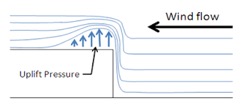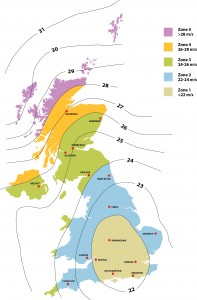The Effects of Wind Uplift on Roofs
The video below was posted on Linkedin recently, by a technician for roofing contractor in the US. What we are seeing here is a fairly extreme case of wind up lift on a flat roof, which will cause significant damage to the membrane. This blog post is about the effects of wind uplift on roofs, and what you can do to ensure that your flat roof doesn’t behave like this.
What is Wind Uplift?
Typically the buildings we develop have big, flat elevations and when coupled with a flat roofs, physics come into play.
 The wind can approach a building from any direction. It will hit a side elevation, causing it to be directed upwards and accelerated. Once it reaches the top of the building it can return to its normal course, however it leaves a void before settling back down over the roof. This void is an area of negative pressure – which has the effect of trying to pull or suck the roof coverings off the remaining structure. This uplift effect is the same force that lifts an aircraft wing.
The wind can approach a building from any direction. It will hit a side elevation, causing it to be directed upwards and accelerated. Once it reaches the top of the building it can return to its normal course, however it leaves a void before settling back down over the roof. This void is an area of negative pressure – which has the effect of trying to pull or suck the roof coverings off the remaining structure. This uplift effect is the same force that lifts an aircraft wing.
Where is Wind Uplift on Roofs an Issue?
You can see from the above diagram that the edge zone of a roof is the most likely to be affected by wind uplift. As the wind can come from any direction, all corner and perimeter zones require a greater resistance to the effects of wind load when being secured. The effect can be worsened if the edges of flat roofs are not correctly fixed, which can allow air to get underneath the roof covering.
It is also important to take into account the location and exposure of the building to determine the effect of Wind Uplift. Northern England, Scotland & Northern Ireland typically will have much higher average wind speeds than those experienced in the South & South East.
Wind speed will also be higher in exposed areas such as on the coast and in open, rural or hilly areas. Tall buildings with no surrounding protection would be more at risk; buildings that are sheltered in a town centre less so.
Wind Load Calculations help Design Out Problems with Wind Uplift on Roofs
On the video, what we are seeing it the roof lifting in negative pressure zones. By using a Wind Load calculation we can ensure that we have sufficient fixings in place to ensure that the wind cannot lift the membrane and the roof does not get damaged.
Even with a wind load calculation it would still be possible to see a loose laid waterproofing covering, such as Mechanically Fastened Single Ply Membrane lift slightly on a windy day, however there are safety factors built in to both wind load calculations & the pull out strength figures used for fixings. By the way, should you be on the roof on a windy day? Probably not. Remember to take the correct Health and Safety Precautions.
If your membrane is to be adhered to the roof (an adhered roof), a wind load calculation really should still be carried out, to ensure that all the components used in the roof build up are capable of withstanding the forces. You can have the best membrane, Vapour Control Layer, glue etc in the world, but if the insulation board facing pulls off at a low value, then this will be the weakest link.
SIG Design and Technology are able to offer Wind Load calculations for all of our products for our customers, clients and specifiers. Get in touch to make sure your roofing membrane doesn’t take off in the wind.
[weathervane picture credit]















looks like on of george kings shirts
I love a good scientific explanation now and again! This is something it’s all to easy to forget about when you’re laying the roof membrane in calm conditions. Roofing is something of an art, and a science too – hence the necessity of making calculations before you even get started. Thanks for the useful reminder of this – no more billowy roofs for us!
Thanks for sharing – a good example of the consequences of overlooking Health & Safety. Good thing there’s a mathematical solution!
Thanks for sharing the effects of wind uplift on roofs. This article is really helpful and educating in scientifically explaining wind uplift. Its really helpful to homeowners and as well business owner when planning on choosing a roofing membrane.
Because of climate change, the weather is unpredictable and the roof takes its toll when it is exposed to wind uplifts, hurricanes, and more. Contacting a reputable roofing contractor would definitely be helpful for installing a high-quality roofing system.
Wind uplift is one of the most common roofing issues that building owners face today. All roofs are subjected to the effects of wind uplift as the wind moves across them. The affects of this will depend upon a number of factors that is why it is critical that a roofing system is designed to withstand the wind loading’s that are likely to impact on the roof during its service life. It’s great that you have shared these scientific explanations about wind uplift here.
One of the best articles I’ve seen about wind uplift. Not many people (outside of the business!) think about this, but it is a common cause of a lot of roofing issues.
[…] traditional insulation systems, it has no wind uplift restrictions. This makes it the ideal choice for buildings located in high wind areas or exposed […]